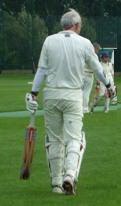 |
| Trott - FB'd by Akhtar September 2010 |
Surely these days there would be an app which would help? There seems to be an app for just about everything else. Perhaps if batting apps must be a thing of the future, help could be found from the range of instructional stuff of varying quality on YouTube.
But nothing quite met his needs, for FB required something deeper. Then he came across some research materials approaching batting from a scientific, biomechanical, sporty-physics, jargony, earnest kind of manner. Could this be the key? A bit of science would help, surely. He began to read............
'Cricket batting is an example of a dynamic interceptive action, placed by Whiting in his second, most complex, category of ball skills – encompassing task constraints where a ball has to be received and sent away within the same movement.' FB thinks this means that you have to hit a moving ball. Presumably the less complex category of ball skills is hitting a non-moving ball - but if this is what Professor Whiting thinks, then he hasn't witnessed FB's repeated disasters on the golf course.
'Batting in cricket requires players to select the most appropriate shot from a wide repertoire of attacking and defensive strokes.' The reference to a wide repertoire of shots must be interpreted carefully in FB's case. FB recognises that the selection of the shot is a critical factor. Having selected his shot many years ago, FB will seek to apply it to all deliveries.
'Successful interception of the cricket ball by the batsman requires the cricket bat to be manoeuvred into the right place at the right time, so that the ball can be struck with the required force to send it in an appropriate direction (Savelsbergh and Bootsma).' FB is grateful to Professors Savelsbergh and Bootsma for this insight which has previously escaped him. He has regularly manoeuvred the cricket bat into the right place at the wrong time, which is only marginally worse than manoeuvring the bat into the wrong place at the right time. He is sure he has also managed to manoeuvre the bat into the wrong place at the wrong time - which takes considerable skill and imagination.
'To achieve this goal, research described in many chapters of this text suggest that skilled batsmen require a combination of unobtrusive footwork, co-ordinated limb movements and precision gripping to deal effectively with the severe task constraints encountered when batting.' FB accepts that the reference to skilled batsmen here may make the succeeding text of no relevance to him. He does however think he has an advanced, possibly unique, understanding of the many severe task constraints encountered when batting. He might not previously have called them severe task constraints and so is glad to know their proper technical name. They include the nagging worry that he might not have locked the back door on leaving home, the team might not have brought enough goodies for tea and he might have to sacrifice his empire biscuit to the opposing skipper, that that lunge forward to the preceding delivery may well have done something to his hamstring, or if not that it has ripped the seam of his trousers and his arse is hanging out in very decorative fashion......... These and many more are severe task constraints - added to which the bowler is about to launch that inswinging yorker in his direction again.............
FB fears that is researches have left him no wiser. However he has long contemplated leaving his body to medical science once his innings is over. He is now determined to leave his forward defensive stroke to science so they may ease the future suffering of mankind.

No comments:
Post a Comment